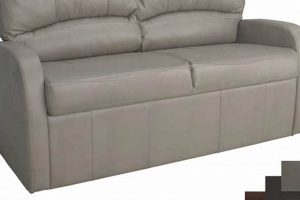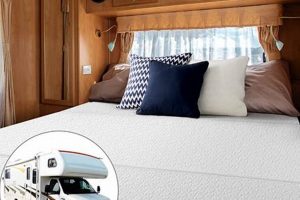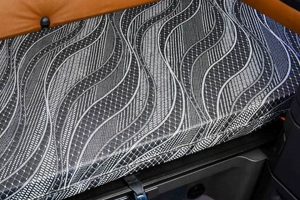These rigid supports are designed to be positioned between a mattress and its supporting structure, such as a bed frame or box spring. They are typically constructed from materials like wood or metal and serve to create a firmer, more even surface for the mattress. A common example is a sheet of plywood placed beneath a sagging mattress to provide additional support.
Their implementation offers several potential advantages. They can extend the lifespan of a mattress by preventing excessive wear and tear caused by uneven support. Individuals may find that these additions improve sleep quality by providing enhanced spinal alignment and reducing pressure points. Historically, rudimentary forms of these supports have been employed for centuries to improve the comfort and longevity of bedding, especially in situations where the underlying structure is inadequate or compromised.
The following sections will delve into the various types of materials used in their construction, examine the specific circumstances under which their use is most beneficial, and provide guidance on selecting the appropriate support based on individual needs and bed frame configurations.
Tips for Utilizing Under-Mattress Bed Boards
Effective implementation of rigid supports placed beneath a mattress can significantly impact its longevity and the user’s sleep experience. The following tips offer guidance on maximizing the benefits derived from this practice.
Tip 1: Measure the Bed Frame. Before acquiring a support, accurately measure the interior dimensions of the bed frame. Ensure the support fits snugly without gaps, as excessive space can negate its intended effect.
Tip 2: Select Appropriate Material Thickness. The thickness of the support is crucial. For minor sagging, a thinner material may suffice. For significant issues, a thicker, more robust option is advisable. Consider the weight of the mattress and occupants when making this determination.
Tip 3: Consider Ventilation. Solid, non-porous supports can restrict airflow, potentially leading to moisture buildup and mold growth. If using a solid material, consider drilling ventilation holes or selecting a perforated alternative.
Tip 4: Prioritize Material Quality. Opt for high-quality materials that resist warping and cracking under pressure. Plywood, for example, should be of a grade suitable for structural applications.
Tip 5: Inspect for Sharp Edges. Before installation, thoroughly inspect the support for any sharp edges or splinters that could damage the mattress or injure the user. Sand down any imperfections or cover them with protective tape.
Tip 6: Distribute Weight Evenly. If using multiple supports, ensure they are evenly spaced beneath the mattress to distribute weight uniformly and prevent localized stress points.
Tip 7: Address Underlying Frame Issues. While a support can compensate for minor frame inadequacies, it is not a substitute for addressing fundamental structural problems. Repair or reinforce a weakened bed frame before relying solely on a support.
These tips emphasize the importance of careful planning and execution when incorporating rigid supports beneath a mattress. Proper implementation contributes to improved mattress performance, enhanced sleep quality, and extended product lifespan.
The concluding section will provide insights into long-term maintenance and care strategies for both the mattress and its underlying support structure.
1. Support
The fundamental purpose of rigid supports designed for placement beneath a mattress is to enhance or augment existing structural support. This intervention is predicated on the recognition that the original support system be it a bed frame, box spring, or platform is insufficient to adequately maintain the mattress’s intended shape and performance characteristics.
- Prevention of Sagging
A primary function of these supports is to prevent or mitigate mattress sagging. Over time, mattresses, particularly those with innerspring or hybrid constructions, may develop depressions or uneven surfaces due to continuous pressure. The addition of a rigid support beneath the mattress distributes weight more evenly, reducing the likelihood of sagging and extending the mattress’s lifespan. For example, a sheet of plywood placed under a sagging mattress can provide immediate and noticeable support.
- Enhanced Spinal Alignment
Adequate support is directly linked to proper spinal alignment during sleep. An unsupported or sagging mattress can cause the spine to curve unnaturally, leading to discomfort, pain, and potential long-term musculoskeletal issues. A rigid support can create a firmer, more level surface, promoting better spinal alignment and reducing pressure points. Individuals experiencing back pain may find significant relief through the use of these supports.
- Weight Distribution
Effective weight distribution is essential for both comfort and mattress longevity. Uneven weight distribution concentrates stress on specific areas of the mattress, accelerating wear and tear. These supports ensure a more uniform distribution of weight across the entire mattress surface. Consider a scenario where two individuals with significantly different weights share a bed; a rigid support can help prevent excessive compression on one side of the mattress.
- Reinforcement of Weakened Structures
In some cases, the underlying bed frame or box spring may be structurally compromised due to age, damage, or poor design. A rigid support can act as a reinforcing element, providing additional stability and preventing further degradation. For instance, placing a support on top of a bed frame with bowed or broken slats can prevent the mattress from sinking and potentially collapsing.
These various facets of support highlight the critical role rigid supports play in maintaining mattress integrity and promoting healthy sleep posture. The effective implementation of these supports requires careful consideration of the mattress type, bed frame construction, and individual needs, ensuring that the added support addresses the specific shortcomings of the existing sleep system.
2. Stability
Stability, in the context of rigid supports placed beneath a mattress, refers to the consistent and unwavering support provided across the entire surface area. This stability is paramount because it directly impacts the mattress’s ability to maintain its intended shape and provide uniform support to the sleeper. Without adequate stability from the underlying support structure, the mattress is susceptible to uneven compression, leading to sagging, discomfort, and reduced lifespan. The supports function to counteract deficiencies in the bed frame or box spring, creating a more level and unyielding foundation.
The
enhanced stability provided by these supports translates directly to improved sleep quality and physical well-being. A stable mattress prevents the formation of pressure points, which can disrupt sleep and cause discomfort. It also promotes proper spinal alignment by ensuring that the body is evenly supported, regardless of sleeping position. Consider the example of an older bed frame with worn-out or widely spaced slats; placing a rigid support, such as a sheet of plywood, across the slats effectively bridges the gaps and creates a stable platform for the mattress. This prevents the mattress from conforming to the uneven surface of the slats and maintains a level sleeping surface.
In summary, the connection between rigid supports and stability is one of cause and effect. The supports are implemented to increase stability, and the resulting stability leads to improved mattress performance, enhanced comfort, and extended mattress longevity. Challenges arise when the support is improperly sized or constructed from inadequate materials, thereby failing to provide the intended stability. Addressing these challenges requires careful consideration of the mattress type, bed frame construction, and the specific stability requirements of the sleep system.
3. Durability
Durability, in the context of rigid supports placed beneath a mattress, signifies the ability of these components to withstand prolonged use and maintain their structural integrity over an extended period. The durability of such a support directly impacts its effectiveness in providing consistent and reliable support to the mattress. This characteristic is not merely a desirable attribute but a fundamental requirement, as a support that degrades or fails prematurely negates its intended benefits and potentially exacerbates the wear and tear on the mattress it is meant to protect. Consider the example of a thin, low-quality piece of particleboard used as a support; it may initially provide adequate support but is likely to warp or crumble under sustained pressure, rendering it ineffective within a relatively short timeframe.
The choice of materials and construction methods significantly influences the durability. Solid wood, high-grade plywood, and certain metals are commonly employed due to their inherent strength and resistance to deformation. However, even with robust materials, proper construction techniques are essential. Weak joints, inadequate fasteners, or insufficient thickness can compromise the overall durability of the support. Regularly assessing the support for signs of wear, such as cracks, warping, or loose joints, is crucial for maintaining its effectiveness. Replacing a damaged or weakened support promptly prevents further damage to the mattress and ensures continued support.
Ultimately, the durability of these supports is an investment in the longevity and performance of the mattress. Selecting high-quality materials and employing sound construction practices ensures that the support will effectively contribute to maintaining the mattress’s structural integrity and providing a comfortable sleeping surface for years to come. Overlooking the aspect of durability can lead to premature failure, necessitating replacement and potentially causing irreversible damage to the mattress, thereby negating any initial cost savings.
4. Thickness
The thickness of a support placed beneath a mattress is a critical parameter that directly influences its ability to provide adequate support and maintain the mattress’s structural integrity. The selection of an appropriate thickness is not arbitrary but rather a deliberate choice based on several factors, including the mattress type, the existing support structure, and the desired level of firmness.
- Weight Distribution Capacity
Thickness directly correlates with the support’s load-bearing capacity. A thicker support can distribute weight more effectively, preventing concentrated pressure points on the mattress. For example, a thicker plywood sheet is more suitable for supporting a heavy memory foam mattress than a thinner one, as it resists bending and sagging under the mattress’s weight. The implications of insufficient thickness include premature mattress wear, uneven sleep surfaces, and potential frame damage.
- Flex Resistance
Thickness determines the support’s resistance to flexing or bending under load. Greater thickness equates to reduced flex, which is essential for maintaining a level and stable sleeping surface. Consider a situation where a thinner support is placed on a bed frame with widely spaced slats; the support may flex between the slats, negating its intended effect. A thicker support would bridge the gaps more effectively, minimizing flex and providing consistent support. The outcome includes inadequate support and potential discomfort.
- Compatibility with Bed Frame Design
The chosen thickness must be compatible with the bed frame’s design. Excessive thickness may create an uncomfortably high bed profile, while insufficient thickness may fail to provide adequate support within the available space. An example would be attempting to use a very thick support in a platform bed with limited clearance; this could raise the mattress too high and create an unstable sleeping surface. This results in reduced comfort and potential safety hazards.
- Material Properties
The optimal thickness also depends on the material properties of the support. Different materials possess varying strengths and flexibilities, influencing the required thickness to achieve the desired level of support. For instance, a steel support may require less thickness than a wooden support to achieve the same level of rigidity. This nuance reflects a critical consideration.
In conclusion, the thickness of a support is not an isolated variable but rather an integral component of a comprehensive support system. Careful consideration of these facets ensures the selection of an appropriate thickness, maximizing the support’s effectiveness in preserving the mattress’s integrity and providing a comfortable sleeping surface. Overlooking the importance of thickness can lead to compromised support, reduced mattress lifespan, and diminished sleep quality.
5. Ventilation
Ventilation is a crucial consideration when implementing rigid supports beneath a mattress. The presence of a solid, impermeable barrier between the mattress and its supporting structure can impede airflow, potentially leading to moisture accumulation and related issues. Therefore, understanding the relationship between support materials and ventilation is essential for maintaining a healthy sleep environment.
- Moisture Buildup and Mold Growth
Restricted airflow can trap moisture released by the human body during sleep. This moisture, combined with warmth, creates an ideal environment for mold and mildew growth within the mattress and on the underside of the support. The presence of mold and mildew can trigger allergic reactions, respiratory problems, and unpleasant odors. As an example, a solid sheet of plywood placed beneath a mattress in a humid climate can significantly increase the risk of moisture buildup compared to a slatted or perforated
support. The implication is a compromised sleep environment and potential health risks. - Material Permeability and Design
The choice of material for the support directly impacts its ventilation properties. Solid, non-porous materials like plywood or solid wood impede airflow, while slatted designs or materials with inherent permeability, such as certain fabrics or perforated boards, promote ventilation. For instance, replacing a solid support with a slatted platform or a board with strategically placed ventilation holes can significantly improve airflow and reduce moisture buildup. The results are influenced directly through this element.
- Mattress Type Considerations
The ventilation needs of a mattress vary depending on its construction. Memory foam mattresses, known for their heat retention properties, benefit particularly from increased ventilation to dissipate heat and moisture. Conversely, innerspring mattresses, with their open structure, generally require less supplemental ventilation. Therefore, selecting a support with appropriate ventilation characteristics based on the mattress type is crucial. Neglecting this aspect can lead to discomfort, reduced mattress lifespan, and an increased risk of mold growth, particularly in humid environments.
- Climate and Environmental Factors
The surrounding climate plays a significant role in determining the need for ventilation. In humid climates, where moisture levels are naturally high, prioritizing ventilation is essential to prevent moisture buildup beneath the mattress. In drier climates, the need for ventilation may be less critical, but it remains a beneficial consideration for maintaining a healthy sleep environment. Consider a scenario where a solid support is used in a humid coastal region; the risk of mold growth is significantly higher compared to a dry, arid environment. The implications underscore the importance of adapting ventilation strategies to local climate conditions.
These facets highlight the importance of considering ventilation when selecting rigid supports for use beneath mattresses. The choice of materials, the design of the support, the type of mattress, and the surrounding climate all interact to influence the need for adequate airflow. By carefully addressing these factors, individuals can create a healthier, more comfortable, and longer-lasting sleep environment.
6. Material
The selection of appropriate material is paramount in the context of rigid supports placed beneath a mattress. Material properties directly influence the support’s ability to provide adequate weight distribution, resist deformation, and maintain its structural integrity over time. The choice is not merely aesthetic; it is a functional imperative directly affecting the mattress’s lifespan and the sleeper’s comfort. For example, using a low-density particleboard may initially seem cost-effective; however, its susceptibility to moisture damage and inability to withstand sustained pressure will quickly lead to warping and collapse, negating any perceived savings.
Different materials offer varying degrees of support, durability, and ventilation. Solid wood, such as pine or oak, provides robust support and resists bending, but it can be susceptible to warping in humid environments. Plywood, particularly marine-grade plywood, offers a balance of strength, stability, and moisture resistance, making it a versatile option. Metal supports, often constructed from steel, offer exceptional strength and durability but can be prone to corrosion if not properly treated. The practical application of this understanding involves carefully assessing the specific needs of the mattress and bed frame, as well as the environmental conditions, before selecting a material. For instance, a memory foam mattress placed on a platform bed in a humid climate would benefit from a plywood support with ventilation holes to prevent moisture buildup.
In summary, the material used in the construction of rigid supports is a critical determinant of their effectiveness. Overlooking this aspect can lead to premature failure of the support, damage to the mattress, and compromised sleep quality. Careful consideration of material properties, construction methods, and environmental factors is essential for maximizing the benefits derived from these supports and ensuring a comfortable and long-lasting sleep system.
7. Compatibility
The suitability of supports placed beneath a mattress represents a critical factor often overlooked during selection. Ensuring the dimensions, material properties, and design of the support align with the existing bed frame and mattress is paramount for optimal performance and longevity of both components.
- Bed Frame Dimensions
The physical dimensions of the support must correspond precisely with the interior dimensions of the bed frame. Supports that are too large will not fit properly, while those that are too small will fail to provide adequate edge support, potentially leading to mattress sagging. An example involves a queen-sized support being placed in a full-sized bed frame, resulting in overhang or incomplete coverage. The implications include compromised support and potential damage to the bed frame or mattress.
- Mattress Type and Weight
The type and weight of the mattress influence the required support material and thickness. Heavier mattresses, such as those constructed with memory foam or latex, necessitate more robust supports to prevent sagging. Conversely, lighter mattresses may be adequately supported by thinner, less dense materials. Placing a heavy memory foam mattress on a thin, flimsy support can result in premature wear and tear. The direct consequence is compromised support and reduced mattress lifespan.
- Bed Frame Construction and Support System
The existing support system within the bed frame must be compatible with the added support. Bed frames with widely spaced slats or a flexible foundation may require thicker, more rigid supports to provide a level sleeping surface. Conversely, platform beds with solid foundations may only require minimal additional support. An example involves placing a thin, flexible support on a bed frame with bowed slats, which will fail to provide adequate reinforcement. The results would include inadequate support and potential discomfort.
- Ventilation Requirements
The design of the support must allow for adequate ventilation, particularly for mattresses prone to heat retention, such as memory foam. Solid supports can trap moisture and promote the growth of mold and mildew. Supports with slats or ventilation holes are preferable in such cases. Placing a solid support under a memory foam mattress in a humid climate can create an environment conducive to mold growth. The impact is a compromised sleep environment and potential health risks.
These components underscore the necessity of careful consideration when selecting rigid supports. Failure to address these compatibility factors can negate the intended benefits of the support, potentially leading to damage to the mattress, compromised comfort, and reduced lifespan. Prioritizing compatibility ensures that the support effectively contributes to a stable and healthy sleep environment.
Frequently Asked Questions
This section addresses common inquiries regarding the implementation
and benefits of rigid supports designed for placement beneath mattresses. The information presented aims to provide clarity and guidance on the appropriate selection and use of these supports.
Question 1: What is the primary function of rigid supports positioned beneath a mattress?
The primary function is to augment or enhance existing support structures, such as bed frames or box springs, that may be inadequate in providing consistent and even support to the mattress. This augmentation helps to prevent sagging, promote proper spinal alignment, and extend the mattress’s lifespan.
Question 2: What materials are commonly used in the construction of these supports?
Common materials include solid wood, plywood (particularly marine-grade), and metal (such as steel). The selection of material depends on factors such as the desired level of support, durability, and resistance to moisture.
Question 3: How does thickness influence the effectiveness of the support?
Thickness directly correlates with the support’s load-bearing capacity and resistance to flexing. Thicker supports generally provide more robust weight distribution and prevent sagging, particularly for heavier mattresses. However, the thickness must also be compatible with the bed frame’s design.
Question 4: Is ventilation a relevant consideration when using supports?
Yes, ventilation is important, especially with mattresses prone to heat retention, such as memory foam. Solid, non-porous supports can trap moisture and promote mold growth. Slatted designs or materials with inherent permeability are preferable to facilitate airflow.
Question 5: How does one determine the appropriate size support for a given mattress and bed frame?
The support’s dimensions should precisely match the interior dimensions of the bed frame to ensure complete coverage and prevent uneven weight distribution. Accurately measuring the bed frame is crucial for selecting a properly sized support.
Question 6: Can these supports rectify underlying structural issues with a bed frame?
While these supports can provide temporary reinforcement, they are not a substitute for addressing fundamental structural problems with a bed frame. Repairing or reinforcing a weakened bed frame is recommended for long-term stability.
In summary, careful consideration of material, thickness, ventilation, and compatibility is essential for maximizing the benefits of rigid supports placed beneath a mattress. Selecting the appropriate support contributes to improved mattress performance, enhanced sleep quality, and extended product lifespan.
The following section will delve into troubleshooting common problems associated with their use.
Bed Boards for Under Mattress
This exploration has illuminated the significant role of supports positioned beneath mattresses in enhancing sleep quality and prolonging mattress lifespan. Key considerations include material selection, thickness, ventilation, and compatibility with the existing bed frame. Improper implementation negates potential benefits, leading to compromised support and diminished comfort. These supports are not a universal solution but rather a targeted intervention best suited for specific scenarios.
The informed application of rigid supports requires a comprehensive understanding of individual needs and existing sleep system limitations. Prioritizing quality materials and precise measurements ensures optimal performance. Continued awareness and responsible implementation will contribute to improved sleep health and the responsible stewardship of bedding investments.







![Best Car Inflatable Mattress Air Bed [Sleep Easy!] Organic & Natural Mattress Buyer’s Guide: Non-Toxic Sleep Solutions Best Car Inflatable Mattress Air Bed [Sleep Easy!] | Organic & Natural Mattress Buyer’s Guide: Non-Toxic Sleep Solutions](https://mattressworldpa.com/wp-content/uploads/2025/07/th-7003-300x200.jpg)